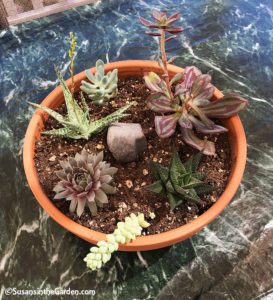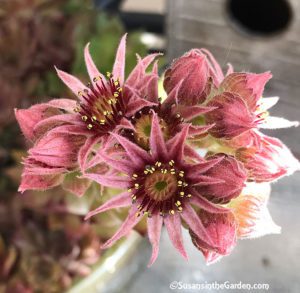July 22 Column: Succulents

Are you as crazy about succulents as I am? I love all of the amazing leaf types and colors, the different sizes and how easy they are to grow. That’s the topic of this week’s column. Here is a link to it in today’s edition of The Spokesman-Review: Versatile succulents gaining in popularity. (or you can read my column lower in this post)
(you can also find this week’s video at the bottom of this post)
The other thing I love about succulents these days is how easy they are to find! In addition to garden centers and home centers, even our local grocery store carries them. And have you see all of the cool containers you can plant them in?! Oh my.
I went to Northland Rosarium the other day and they have all sorts of fun containers such as moss-covered handbags, cowboy boots (!), along with more traditional style pots.
As I mentioned in my column, the two hardy types of succulents that will grow in this region (zones 5-6): Sedums and Sempervivums. And they are very cool-looking, however, I guess it’s in my nature to want what I can’t have, right? So I recently purchased several of the more “exotic” genera, with the plan to move the container indoors before it frosts this falls. This means I”ll need to give them a lot of light, of course, so hopefully I can keep them happy all winter long!
Below left, there’s a photo of my newest succulent container: as you can see, it’s filled with a little of this and a little of that. And on the right is a close-up of the flowers on one of my hens-and-chicks. Aren’t they stunning?


I also wanted to share this week’s “Everyone Can Grow a Garden” video with you. The topic is preserving the harvest, which came about because I get a lot of questions about how we keep our produce through the winter months:
Succulents garden column:
By Susan Mulvihill
Succulents are truly the darlings of the horticultural world. With their wide variation in leaf colors and types, they have soared in popularity in recent years. They are frequently potted up in eye-catching combinations to dress up a deck, potting table or even indoor living spaces.
If you’re not familiar with succulents, think of hens-and-chicks — no, not the barnyard type but those thick-leaved, carefree plants that are usually surrounded by “flocks” of baby plants. Hens-and-chicks are just one example, however.
Background on succulents
According to John Bagnasco and Bob Reidmuller, authors of “Success with Succulents” (Cool Springs Press, 192 pp. $24.99), “Succulents are water-thrifty plants that are adapted to dry environments in which the leaves, stems, or roots have become unusually fleshy from the development of water-storing tissue…. They come in a plethora of styles, sizes, and colors.”
It’s easy to find them at nurseries, garden centers and even in grocery stories.
The hardiest succulents
Sedum and Sempervivum are the hardiest genera that will survive our winters and don’t seem to mind tough, dry conditions. While there are so many other types of succulents that aren’t cold-hardy, that doesn’t mean you can’t grow them. Just plant them in containers outdoors during the garden season and then bring them inside before freezing temperatures arrive in the fall.
Some of my favorite succulents include Echeveria, Aeonium and Crassula. Lithops, also known as “living stones,” have recently appeared on the scene and caught my eye.
As Bagnasco and Reidmuller explain, “Lithops have two fleshy lobes with a cleft between them and nearly flat tops, usually decorated in various random markings in earth-toned colors.
Native to South Africa, these intriguing succulents exist in gravelly terrain. With the tops being the only parts visible, their camouflage markings protect them from being eaten by grazing animals. What an interesting adaptation.
Growing and caring for succulents
Because most succulents prefer full to part sun, they are best grown outside. If your soil doesn’t drain well, add in compost or other amendments to help water flow through it.
The plants require a minimal amount of care. Even though they are very tough, they do require water especially when summertime temperatures heat up.
When planting succulents in containers, be sure to select pots with drainage holes since good drainage is crucial. Choose a potting soil labeled for succulents and cactuses.
I’ve seen so many fun and whimsical containers at local nurseries. They range from moss-covered handbags and cowboy boots, to birdhouse roofs and wooden trugs. There are plenty of traditional types of pots available as well, so this is an opportunity to let your creativity shine through. I think mixing a variety of succulents together is really appealing.
When fall approaches, it’s time to move the more exotic succulents indoors. For the best possible success, provide them with as much light as possible. If you notice the plants are stretching toward the light, that means they’re not getting enough. To resolve this, consider keeping them under grow lights that are turned on for 12 to 14 hours a day.
While the succulents are indoors for the winter, water them occasionally and make sure the containers are draining well. Avoid the temptation of fertilizing them, however, as the plants will be in a dormant period.
Once the danger of frost has passed next spring, it will be safe to move those succulents back outdoors. Just remember to ease them back out into the real world so their leaves won’t burn.


